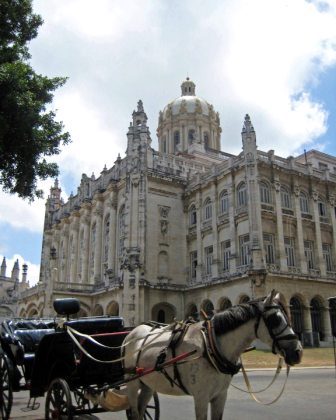In Front of the Palace with My Parents
Dmitri Prieto

Every time I’m about to enter the tunnel that goes under Havana Bay from Old Havana, I glance at the former Presidential Palace, which today is the Museum of the Revolution. In front of the building is a small tower on a remaining section of the colonial wall that once circled the city.
In addition, located there is a mobile piece of artillery that the Soviets sent at the beginning of Cuba’s socialist stage. All this is surrounded by a park with grass and palm trees.
I used to walk through that area with my parents in the distant decade of the 1970s, when my dad would tell my mom and me stories about the Cuban Revolution. I remember looking at the strange shield of the Republic mounted over the Palace and wondering how the “Yankees,”who were such bad guys, used the same native symbols of Cuba that the revolutionaries had used.
The Cuban Revolution was fresher and more recent than the Russian one of 1917, and the rhythm of the time felt close.
Its history seemed to be lingering in the air, along with the salt from the sea. Those summers allowed me to feel the pulsations that accompany major historical changes.
Such a capacity is always useful, especially in times like the current ones, but of course these thoughts are from today. In the ‘70s, I only walked and ran around in front of the Palace in the company of my parents, though I sometimes posed questions that were a bit strange.
I remember one of these: “Mom, what did they do with the bad guys when the Revolution triumphed? Did they kill all of them?”
My mother responded, “Well, they killed some of them and reeducated others.” The massive exodus of 1980 had not yet occurred and for some reason the issue of immigration had still not come up.
Later, at the Soviet school, I had to read a novel by Arkadi Gaidar, who was an inspired chronicler of the first quarter of the century in the country of the soviets. He was preferred by the ideologists for developing revolutionary feelings within teenagers.
In the novel, a young secondary school student is being trained by the Bolsheviks in the communist virtues. One of the first tasks he is assigned is to shoot a member of the “white” Russian forces (a counter-revolutionary). After killing that individual, the protagonist vomits – though his trainer convinces him that the death was necessary, if not indispensable.
Reading the episode about the shooting gave me no desire at all to throw up. At that time, in front of the Palace, I saw it as something absolutely normal to kill an ideological enemy in cold blood.
What’s interesting is that Egor Gaidar, the now-deceased grandson of the Bolshevik writer of children’s books, was one of the architects of the neo-liberal reforms that were so costly for post-Soviet Russia.
In Cuban literature there doesn’t exist an equivalent to Gaidar.
A few weeks ago, the Cuban government commuted the death sentence that had been handed down against an imprisoned Salvadoran terrorist. In fact, it has been several years since anyone has been executed by firing squad in Cuba.
The Cabaña fortress, where several political regimens shot hundreds of people, can be seen very well from the esplanade in front of the Palace.





